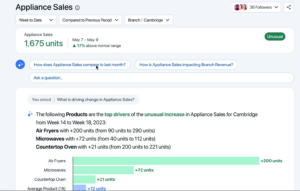
Tableau Jumps Into Generative AI with Tableau GPT

(SuPatMaN/Shutterstock)
Tableau hopes to democratize access to its products with a pair of announcements made today at its annual user conference, including Tableau GPT, which allows users to ask questions using natural language, and Tableau Pulse, a new user interface that houses Tableau GPT. The company also announced its first data cloud and unveiled VizQL Data Services, Tableau’s first headless BI offering.
The launch of ChatGPT in November 2022 highlighted the immense progress the AI community has made in the fields of natural language processing (NLP) and natural language generation (NLG). Leveraging a pre-trained large language models (LLM) based on the public Internet, ChatGPT has opened the door for all sorts of new developments, and it’s not closing anytime soon.
Software companies of all stripes are rushing to adopt ChatGPT and other LLMs like it in an effort to streamline how users interact with their products, and in some cases create entirely new experiences. For vendors in the BI and analytics space, such as Tableau, the top use case involves using the LLM in concert with the BI and analytics tool.
Analytic vendors are plugging the LLM in as an intermediate layer between the English language-speaking user and the BI tool, which generates SQL to power the analytics query. On the flip side, the LLM can leverage its vast “knowledge” of how words go together to convert the data returned by the query and generate an English-language explanation of what it means.
Tableau is not using the LLM to generate SQL with Tableau GPT, which it officially unveiled this morning during its user conference in Las Vegas, Nevada, but it using using LLMs to enable users to explore data through a natural language conversation with an analytics database. Tableau GPT can also suggest questions to ask, automatically summarize reports for user, and keep track of metrics on behalf of the user, says Pedro Arellano, GM and head of product at Tableau.

Tableau Pulse helps by displaying queries suggested by Tableau GPT, displaying results, and sharing insights via Slack
“Tableau GPT is a new suite of capabilities that infuses the power of generative AI throughout the entire platform,” Arellano said in a press conference yesterday. “It can enhance and automate things like analyzing data, exploring it, sharing it, consuming it. It introduces a number of really exciting use cases, where for example analyzing data feels more like a conversational Q&A as opposed to a drag and drop. Or imagine anticipating questions that users might ask based on what’s already in the data, or taking hundreds of insights and explaining them using very easy to understand summaries.”
Tableau GPT is based on Salesforce’s Einstein GPT, which Salesforce unveiled in early March. It uses a variety of LLMs, including some developed by its partner OpenAI, but also other proprietary models, Tableau exeuctives said.
Users will interact with Tableau GPT through a new user interface called Tableau Pulse. Customers will have natural language conversations with Tableau GPT within the Pulse interface, and will also view metrics that Tableau GPT is tracking for them within Pulse. Pulse will also help guide users through the data exploration process by finding connections in the data. Integration with Slack, which is also owned by Salesforce, for both Tableau Pulse and Tableau GPT will facilitate sharing of insights.
Tableau Pulse represents “a complete re-imagining of the analytics experience” for Tableau, Arellano said.
“It is no longer just about exploring data,” he said. “It’s also about communicating it and consuming it. It is no longer just about expressing yourself through visualizations. It’s also about language. It’s not just primarily for analyst. It’s for consumers. It’s for everybody. And it’s sort of a personal guide for your data, where it knows your data, it knows the goals you’re trying to achieve, and it helps you reach those goals.”
The company also unveiled Data Cloud for Tableau, which is based on the Customer Data Cloud that Salesforce unveiled in September. Just as Salesforce’s data cloud functions as a database for customers to store and serve a variety of data they may need for CRM and customer 360 purposes, the Data Cloud for Tableau provides a type of database for Tableau customers to store and access third-party data may need for analytics and BI use cases, says Francois Ajenstat, chief product officer at Tableau.
“Data Cloud is away to very effortlessly, very quickly, bring together all of the data that’s in the Customer 360; harmonize it, model it, organize it, do things like identity resolutions, and then layer Tableau on top of it, so you can explore all that data very instantly,” Ajenstat said during Monday’s press conference.
Finally, Tableau took the wraps off another new offering called VizQL Data Services. The product is based on VizQL, which is Tableau’s visual query language for databases and resides at the heart of the Tableau product set. With the launch of VizQL Data Services, the company is essentially providing a headless BI service for developers to take advantage of Tableau insights in other applications, Arellano said.
“Earlier I talked about how we are reimagining the experience for the analytics consumer with Tableau GPT and Tableau Pulse. With VizQL data services, we’re doing this for the developers,” he said. “You might have heard concepts like composable analytics or headless BI. With VizQL Data Service, essentially what we’re doing is decoupling the front-end Tableau visualization from the magic of Table at its core, the VizQL data engine. And we’re putting that power in the hands of developers, so they can build whatever experience they want.”
Taken as a whole, the announcement Tableau is making at its user conference shows that the company is serious about reaching the 70% of workers at the average company who do not yet have access to data, Ajenstat said. It’s also about paving the way for the next 20 years of innovation at the company, he said.
“When you look at the innovations that we talked about today, it is that new day for data,” he said. “New experiences for consumers. New experiences for developers. New ways to bring data together, enabling IT to be more successful. Just new ways to see and understand data.
“This is really an exciting time for Tableau and an exciting time for this industry because data continues to grow, and the importance of data continues to grow,” he said. “So what we need to do is bring it and make it consumable, make it actionable, make it relevant to as many people as possible. This is what we’re doing and this is what we’re sharing at this conference.”
Related Items:
Which BI and Analytics Vendors Are Incorporating ChatGPT, and How
Salesforce Goes All-in on Generative AI with Einstein GPT, Integration with OpenAI
Like ChatGPT? You Haven’t Seen Anything Yet
Editor’s note: This story has been corrected. Tableau is not using LLMs as an intermediate layer to generate SQL. Datanami regrets the error.
































